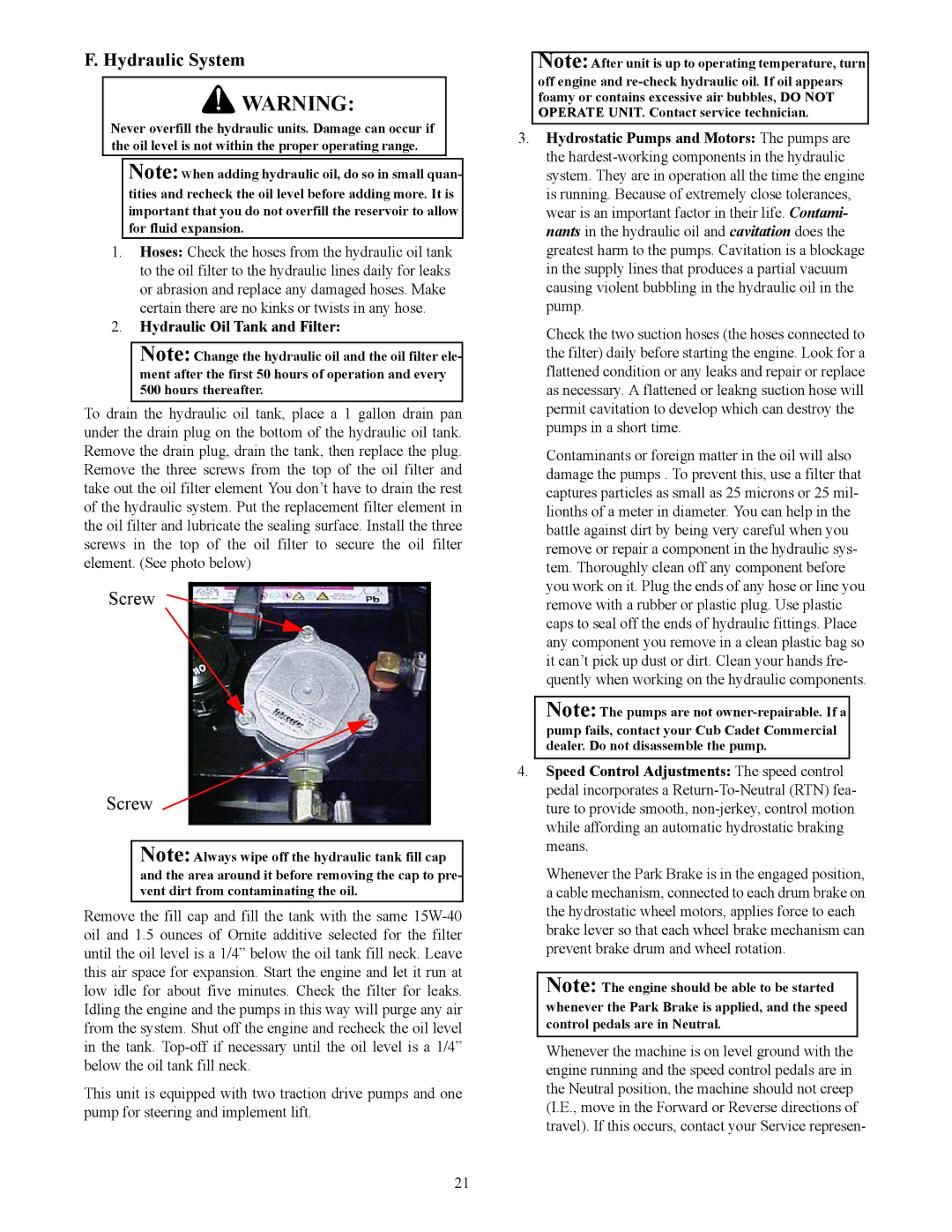
F. Hydraulic System
![]() WARNING:
WARNING:
Never overfill the hydraulic units. Damage can occur if the oil level is not within the proper operating range.
Note: When adding hydraulic oil, do so in small quan-
tities and recheck the oil level before adding more. It is important that you do not overfill the reservoir to allow for fluid expansion.
1.Hoses: Check the hoses from the hydraulic oil tank to the oil filter to the hydraulic lines daily for leaks or abrasion and replace any damaged hoses. Make certain there are no kinks or twists in any hose.
2.Hydraulic Oil Tank and Filter:
Note: Change the hydraulic oil and the oil filter ele- ment after the first 50 hours of operation and every 500 hours thereafter.
To drain the hydraulic oil tank, place a 1 gallon drain pan under the drain plug on the bottom of the hydraulic oil tank. Remove the drain plug, drain the tank, then replace the plug. Remove the three screws from the top of the oil filter and take out the oil filter element You don’t have to drain the rest of the hydraulic system. Put the replacement filter element in the oil filter and lubricate the sealing surface. Install the three screws in the top of the oil filter to secure the oil filter element. (See photo below)
Screw
Screw
Note: Always wipe off the hydraulic tank fill cap and the area around it before removing the cap to pre- vent dirt from contaminating the oil.
Remove the fill cap and fill the tank with the same
This unit is equipped with two traction drive pumps and one pump for steering and implement lift.
Note:After unit is up to operating temperature, turn off engine and
3.Hydrostatic Pumps and Motors: The pumps are the
Check the two suction hoses (the hoses connected to the filter) daily before starting the engine. Look for a flattened condition or any leaks and repair or replace as necessary. A flattened or leakng suction hose will permit cavitation to develop which can destroy the pumps in a short time.
Contaminants or foreign matter in the oil will also damage the pumps . To prevent this, use a filter that captures particles as small as 25 microns or 25 mil- lionths of a meter in diameter. You can help in the battle against dirt by being very careful when you remove or repair a component in the hydraulic sys- tem. Thoroughly clean off any component before you work on it. Plug the ends of any hose or line you remove with a rubber or plastic plug. Use plastic caps to seal off the ends of hydraulic fittings. Place any component you remove in a clean plastic bag so it can’t pick up dust or dirt. Clean your hands fre- quently when working on the hydraulic components.
Note: The pumps are not
4.Speed Control Adjustments: The speed control pedal incorporates a
Whenever the Park Brake is in the engaged position, a cable mechanism, connected to each drum brake on the hydrostatic wheel motors, applies force to each brake lever so that each wheel brake mechanism can prevent brake drum and wheel rotation.
Note: The engine should be able to be started
whenever the Park Brake is applied, and the speed control pedals are in Neutral.
Whenever the machine is on level ground with the engine running and the speed control pedals are in the Neutral position, the machine should not creep (I.E., move in the Forward or Reverse directions of travel). If this occurs, contact your Service represen-
21
